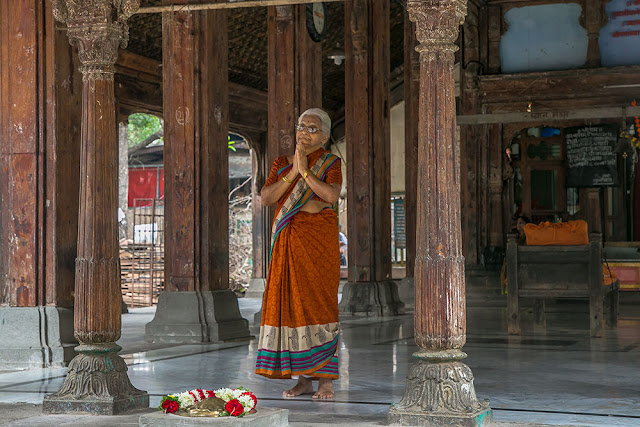Built during the zenith of Peshwa rule in Pune, the
Ram temple at Tulsibaug is one of the few places which have survived in an almost intact form even after years of neglect. Though the neighbourhood has change dramatically, Tulsibaug wada, where the temple is located, has remained the same and a visit to this temple literally takes you back in time. Located right in the middle of one of the noisiest parts of old city, the ambience around the temple is extremely calm and soothing. By the way, this is also my favourite temple in the city and the one I can visit over and over again and never get bored of it :)
 |
| Ram Temple at Tulsibaug, Pune |
 |
| An old lady praying at the temple |
 |
| Wooden Sabhamandap |
History of Ram Temple
The history of the temple is closely linked to the rule of
Peshwas in the region, especially Pune. The Maratha kingdom was a powerful kingdom, especially under Shivaji the much respected and feared Maratha king from the 17th century. While Marathas were in power, their Prime Ministers were known as
Peshwa, something similar to how the
Nawabs of Lucknow were connected to the the Mughal rulers of Delhi.
Read more:
The legend of Bhul Bhilaiya in Lucknow
However, after Shivaji's death the kingdom lost some of it's sheen especially after his son was killed by Mughal king Aurangzeb. However, soon after Aurangzeb also died at Aurangabad (not too far from Pune) and with him also started the decline of the Mughal empire. The local population rose again, this time with the much stronger Peshwas who were based of out Pune. The Maratha kings became more of a figure head while it was the Peshwas who ruled the kingdom and took it to great heights. The Maratha Kingdom finally came to an end in 1818 and the British took over as the rulers of the region.
However, it was during the zenith of Peshwa rule/ Maratha rule that the Ram temple was built at Tulsibaug. This was an era when some of the biggest palaces were also built in the region, like the Shaniwarwada. The temple was built by Jivajipant Khasgiwale when Balaji Baji Rao was the ruling Peshwa, however it was only in 1761 that the temple was finally completed when Madhav-Rao I ruled.
The prominent 150m tall
shikhar (the inverted conical structure with stucco work) was added much later in the 19th century, but the wooden temple has otherwise remained unchanged over the years. Surrounded by shops, the Tulsibaug wada is a busy space, but there is a strange kind of calm which still exists here. Unless it's a special day, the temple is devoid of people on most days, especially early in the morning and afternoons when many shops shut shop for a few hours for rest.
 |
| 150m tall shikhar |
 |
| Nagarkhana |
 |
| Another view of the temple |
 |
| Some art on the walls around the temple... |
 |
| Another smaller temple in the courtyard |
As is obvious from the name the temple is dedicated to Lord Rama and has the
garbhagriha has idols of Ram and Sita. The other obvious part is the presence of
tulsi (basil) which was present here in abundance and gave the area it's name. Tulsi is an important offering to Lord Rama and hence it's presence around the temple was essential. Now there are a few
tulsi plants in pots around the temple, but no tulsi gardens.
Here's a short video form a recent visit to the temple early in the morning when there was absolutely no one there. Keep the volume on to hear the sounds of bird chirping all around me making the place even more peaceful and relaxed. I even sat for a while and read a book there :)
Here is another excellent account of the
Ram temple at Tulsibaug. Do check it out.








Never knew the origin of the name.
ReplyDeleteThose pillars are old but still strong.
Absolutely! Old yet strong :)
DeleteBeautiful temple, love the wood work. Went there during the heritage walk I did with Janwani.
ReplyDeleteDid you know that locals used to refer to the shopping complex around the temple as a mall. Apparently women had to go here to buy personal items.
I bought lovely brass vessels for my daughter to play with! :)
Lovely Chaitali! I've been to this mall so many times, but never bought anything...maybe next time :)
DeleteI felt very nice n peace full while visited.an unknown love n attraction of simplicity lies in this tample.
ReplyDeleteI really love to visit every time.:)
Nice to know about this temple and its stories.
ReplyDeleteInteresting read! Great Insight :)
ReplyDeleteThank you Veidehi :)
Deleteis there any old authentic ashram in pune where outsider come and stay n do dhyan kirtan for few days. actually detoxification from digital world :-) .
ReplyDeletethank you.
Unfortunately, I don't know Animesh...
DeleteThanks for sharing great, inspirational and very informative travel story and Ram Temple History.
ReplyDeleteThanks Devesh :)
DeleteReally amazing article ... very nice ... Thanks for sharing this!! :) :)
ReplyDeleteThank you :)
DeleteHi! Nice article. Do check my travelogue about Pune heritage places.www.questraveler.com I would be happy to receive your comments.
ReplyDeleteI had a look...good work :)
DeleteGreat Blog. Happy to hear the details of RAM TEMPLE AT TULSIBAUG. Thanks for sharing this information with us.
ReplyDeleteThanks Alexander :)
DeleteThis temple is very nice my wish i can trevall with my family because this temple is looking very good in pics these pics are very good and thank you Siddhartha Joshi for share you experiance
ReplyDelete